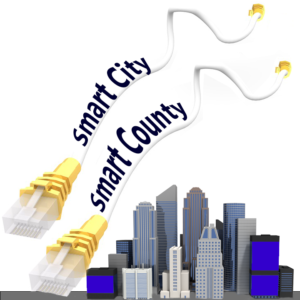Move over, Smart Cities…you’ve got company!!
Snohomish County in the state of Washington is about to be the second county in the United States to become designated a Smart County. Durham County, in North Carolina, was the first.
Municipal leaders cornered the market on being recognized as they launched initiatives to combine data, communication and information technology for the benefit of citizens. They became known as Smart Cities and the benefits have been abundant. But, now, counties are coming on strong. County officials have realized that what’s good for cities is also good for counties.
What does all this mean? How does a county become a “smart county?” First of all, it takes visionary leadership. Public officials are expected to collaborate with private-sector partners, nonprofits, universities, citizen and taxpayer groups to implement initiatives that improve citizen services, boost the economy, enhance quality of life for residents and lay a strong foundation for sustainability.
Snohomish County cast a broad net when it released a request for information (RFI) from interested partners. The county reached out for assistance and called for ideas that would help grow the local economy and address a problem often exclusive to counties – the unique needs of citizens in both rural and urban communities.
 Counties could take a few pointers from cities in Texas that are currently involved in Smart City initiatives. The city of Austin created a coalition – individuals, organizations and subject matter experts – to develop strategies that would provide better access to transportation, create new mobility standards and enhance existing infrastructure. The ideas they developed landed the city on a short list as a finalist in the U.S. Department of Transportation’s Smart Cities Challenge.
Counties could take a few pointers from cities in Texas that are currently involved in Smart City initiatives. The city of Austin created a coalition – individuals, organizations and subject matter experts – to develop strategies that would provide better access to transportation, create new mobility standards and enhance existing infrastructure. The ideas they developed landed the city on a short list as a finalist in the U.S. Department of Transportation’s Smart Cities Challenge.
San Antonio held its own Smart Cities Readiness Workshop and involved leaders from transit, water, energy, higher education and nonprofit organizations. The group of more than 100 focused on issues and initiatives that addressed such issues as mitigating traffic congestion, improving pedestrian safety, providing Wi-Fi access, installing LED street lights and addressing water, energy, workforce development and sustainability.
Elsewhere in the U.S., Albuquerque is considered a leader for digitalization initiatives. The city has installed fiber cable that provides high-speed broadband access to homes and businesses along a rapid transit corridor. The city also expanded its high-speed Internet access to dozens of public buildings – community facilities, senior centers and police and fire stations. LED lighting has been installed throughout the city. Several sensor projects now allow the city to collect data to better manage solid waste disposal and to generate lighting efficiencies.
In Columbus, Ohio, a smart city project allows people to use a trio of electric self-driving shuttles. These transportation options link a new rapid transit center to the retail district, efficiently connecting residents to workplace locations.
Smart county initiatives are a little different, primarily because counties must take into consideration unique factors, such as population density. And, counties look for initiatives that benefit taxpayers, students, businesses and healthcare providers.
Smart counties are not limiting themselves to any particular types of initiatives. Most are seeking collaborations and partnerships that address technology projects related to the Internet of Things (IoT). But, they also are launching projects to improve transportation, rural broadband, data analytics, urban wireless networks and sensor-based networks.
Whether the “smart” moniker is attached to a city or county, the goals are similar. Government leaders all seek to increase local economies, provide better citizen services, lay a solid foundation for sustainability and enhance the quality of life for citizens.
Citizens are well served when public officials in their region decide to commit to challenges such as these. Smart City visionaries should watch to see that Smart County leaders don’t go around them in the months to come.
Since 1995, SPI’s procurement consulting services have helped companies of all sizes effectively navigate the various jurisdictions of government procurement. Contact them today to learn how they can help grow your business.

 512-531-3900
512-531-3900 Request More Info
Request More Info
